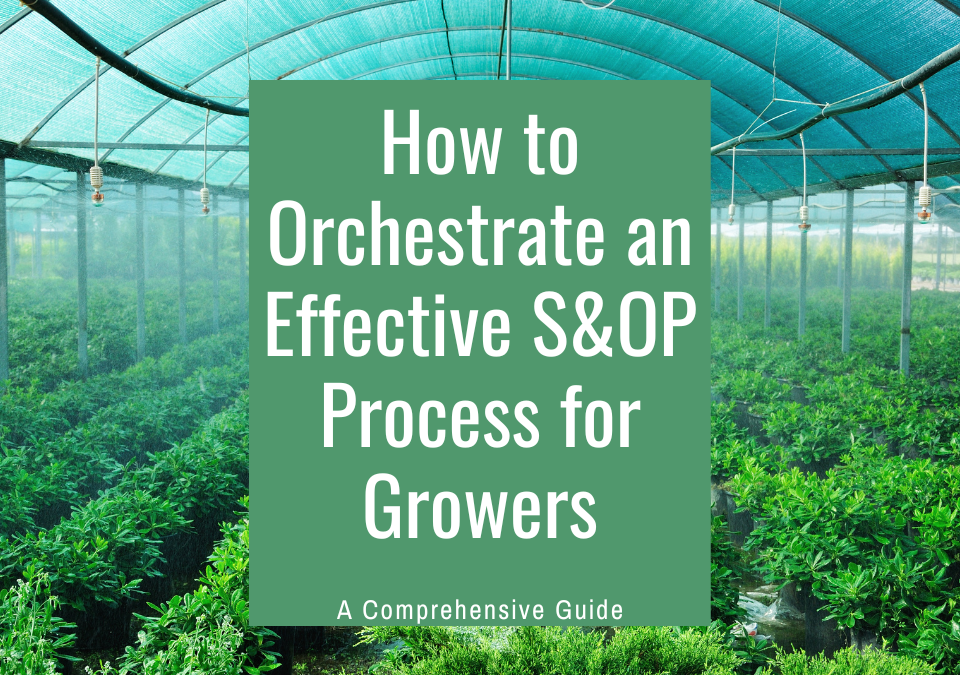
Understanding The Financial Impact Of Credit Card Fees For Growers and What To Do About It
January 31, 2024
Key Elements for Effective Item Identification in Inventory Management Systems
February 26, 2024This is a an AGS Guest Expert Blog post by Sharat Prakash. Sharat Prakash is an expert in supply chain and grower data analytics, grower data modeling, and ERP systems. Sharat is a former employee of AGS who has gone on to gain experience in other financial and supply chain modeling, analytics and data architecture assignments and is now the Senior Manager of ERP and Analytics at Metrolina Greenhouses.
In the dynamic world of large-scale greenhouse growing, Sales and Operations Planning (S&OP) emerges as a strategic cornerstone for success. S&OP is a collaborative management process designed to align sales, marketing, production, procurement, logistics, and finance functions within an organization. It helps integrate the collective benefits of exceptional customer service, lean inventory management, cost-efficient production, agile crisis response, and collaborative efficiency within the framework to drive overall corporate success and align with corporate SMART – Specific, Measurable, Acheivable, Relevant, and Time-Bound goals.
Key Strategic Goals for a modern S&OP:
1. Customer-Centric Operations:
Enhance customer satisfaction through precise product delivery by optimizing S&OP processes. Align production plans and supply chains with customer demand, fostering loyalty in the competitive market.
2. Lean Inventory Management:
Achieve high inventory turnover for improved cash flow. Utilize S&OP to minimize holding time, eliminate stock-outs, and optimize overall inventory efficiency.
3. Cost-Efficient Production:
Improve profitability through efficient production by aligning S&OP with market demand. Ensure resource utilization is optimized through agile and demand-driven production plans.
4. Agile Crisis Response :
Safeguard profitability through proactive crisis response. Integrate scenario planning within S&OP to swiftly address supply chain disruptions and ensure continuous business operations.
5. Collaborative Efficiency:
Streamline operations for increased profitability. Leverage S&OP to foster cross-departmental collaboration, reduce waste, and optimize costs, ensuring efficient and cohesive business processes.
By making these goals the cornerstone of S&OP, large-scale greenhouse growers can strategically position themselves for success in the competitive horticulture industry.
As the Senior Manager of ERP and Analytics at Metrolina Greenhouses, a leading player in the horticulture industry, I am excited to explore the intricacies of S&OP and demonstrate how this process can significantly benefit growers. This article aims to shed light on key performance indicators (KPIs), industry best practices, and the pivotal role of S&OP in optimizing operational efficiency. Additionally, we’ll emphasize the crucial contribution of ERP systems and business intelligence tools in enhancing decision-making capabilities for large-scale growers.
Key Components of S&OP and Their Role for Big Growers:
1. Demand Planning:
– Forecasting customer demand based on historical data, market trends, and customer buying behavior.
2. Sales Planning:
– Aligning sales strategies with anticipated demand and market conditions to drive revenue.
3. Production Planning:
– Creating production schedules that optimize capacity, resource utilization, and meet forecasted demand.
4. Inventory Planning:
– Optimizing inventory levels to prevent stockouts or overstock situations and ensure a balanced supply chain.
5. Financial Planning:
– Evaluating the financial impact of S&OP decisions, ensuring alignment with organizational goals.
6. Cross-Functional Collaboration:
– Facilitating communication and collaboration among different departments for a cohesive and well-coordinated plan.

Copyright Advanced Grower Solutions
Collaborative Cross-Functional S&OP Team
Sales and Operations Planning in Action, it is a team sport:
The S&OP journey transcends mere meetings, commencing with meticulous data collection and concluding when the orchestrated plan is seamlessly executed. Intrigued by the seamless integration of sales and operations planning? Delve into the intricacies of the six-step S&OP process.
1. Data Gathering and Management (Forecasting):
Each team diligently compiles data for the specified time frame, encompassing past sales, trend analyses, and plan success rates. The data undergoes formatting into forecasts by the demand planner, with key departments such as sales, marketing, operations/supply, logistics, and finance actively participating. An ideal scenario involves software solutions that continuously compiles this information – ERP, BI Solutions, EDI Integrations.
2. Demand Planning:
Following validation of forecasts for variability, adjustments are made, and a demand plan is constructed. Managed by the demand planner, input from sales and marketing is essential in finalizing the plan before the pivotal S&OP meeting.
3. Production and Supply Planning:
Leveraging the demand plan, the head of supply collaborates with operations to craft a comprehensive supply plan. This plan encompasses inventory targets, safety stock, production methods, potential capacity liabilities – space and labor, inventory scheduling, and any necessary pre-launch logistical adjustments.
4. Pre-S&OP Meeting (Plan Reconciliation):
The supply and demand plans undergo reconciliation, with adjustments made based on their realistic accommodation of each other. The finance department plays a pivotal role in this stage, ensuring that all plans align with a pre-established budget. If substantial cost-related challenges arise, this juncture becomes critical for assessing the financial feasibility of proceeding with the plan.
5. Executive S&OP Meeting:
With all details meticulously finalized, the plans take center stage at the executive S&OP meeting, where key managers and leaders meet to review key data and plans for decisions. The goal is to conclude the meeting with a well-defined, agreeable plan poised for implementation across the entire organization.
6. Implementation:
After the executive meeting, each departmental leader collaborates with their team and cross-functionally to enact the changes outlined in the plan. Regular evaluations of the implementation process are recommended to ensure alignment with strategic objectives and make any necessary adjustments.

Copyright Advanced Grower Solutions
To effectively implement S&OP for large-scale growers, we must focus on specific KPIs and leverage industry best practices:
Key Performance Indicators (KPIs):
“What Get Measured Gets Managed! – From Measure What Matters by John Doerr.”
1. Sales Plan vs Actual%:
This metric measures the variance between planned and actual sales, providing insights into demand forecasting accuracy. Calculate the percentage difference between actual sales (in units or dollars) and planned sales by dividing the actual sales (units or dollars) by planned sales (units or dollars) and multiplying by 100.
2. Production Plan vs Actuals%:
Like Sales Plan vs Actual, this metric evaluates the effectiveness of production planning by comparing planned production with actual output. Calculate the percentage difference between actual production (in units or dollars) and planned production by dividing the actual production (units or dollars) by planned production (units or dollars) and multiplying by 100.
3. Production Scrap%:
Scrap percentage measures the proportion of scrapped units after production relative to total sales dollars, highlighting efficiency in minimizing waste. Calculate the scrap percentage by dividing the total scrap value by total sales dollars and multiplying by 100.
4. Scrap% for Consignment%:
This metric is similar to Production Scrap%, focusing on dollars scrapped at retail stores for products not sold within the expected timeframe. Calculate the scrap percentage for consignment by dividing the consignment scrap value by total consignment sales dollars and multiplying by 100.
5. Greenhouse Space Utilization%:
This metric compares actual utilized greenhouse space to planned space utilization, indicating the efficiency of space management. Calculate the greenhouse space utilization percentage by dividing the actual utilized space by planned space utilization and multiplying by 100.
6. Margin%:
Margin percentage calculates the profitability of products by assessing the proportion of profit relative to total revenue. Calculate the margin percentage by dividing the profit by total revenue and multiplying by 100.
7. PARETO Analysis of Products:
This analysis identifies the top 20% of products contributing to 80% of revenue, helping prioritize focus and resources.
8. Labor Spend Plan vs Actual%:
This metric ensures optimal resource allocation by comparing planned labor spend with actual expenses. Calculate the percentage difference between actual labor spend and planned labor spend by dividing the actual labor spend by planned labor spend and multiplying by 100.
9. Raw Material Availability%:
This metric monitors the availability of essential raw materials by their categories by comparing current on-hand quantities to expected quantities. Calculate the raw material availability percentage by dividing the current on-hand quantity by the expected on-hand quantity and multiplying by 100.
10. Order Fulfillment Rate%:
This metric measures the efficiency of order fulfillment processes to enhance customer satisfaction. Calculate the order fulfillment rate by dividing the number of orders fulfilled on time by the total number of orders and multiplying by 100.
11. Supplier On-Time Delivery%:
Tracks the on-time delivery performance by suppliers, ensuring timely receipt of materials. Calculate the supplier’s on-time delivery rate by dividing the number of on-time deliveries by the total number of deliveries and multiplying by 100.
12. Supplier Credits%:
Measures purchase returns placed on supplier receipts, assessing the financial impact of returned items. Calculate the supplier credits percentage by dividing the value of supplier credits by total supplier receipts and multiplying by 100.
13. Supplier Fulfillment Rate%:
Like the customer order fulfillment rate but focuses on suppliers, evaluating their efficiency in fulfilling orders. Calculate the supplier fulfillment rate by dividing the number of supplier orders fulfilled on time by the total number of supplier orders and multiplying by 100.
14. Inventory Turnover:
Measures inventory turnover by different product categories, indicating how quickly products are sold and replaced. Calculate the inventory turnover by dividing the cost of goods sold (COGS) by the average inventory.
15. Yield%:
Yield measures the efficiency of production by calculating the ratio of total units produced to total growing space. Calculate the yield by dividing the total units produced by the total growing space.
16. Ready Date Fulfillment%:
Measures the effectiveness of meeting scheduled ready dates based on grow times for products or plant varieties. It provides insights into the organization’s ability to adhere to planned production schedules and ensure timely availability of products for delivery or distribution. Calculate the percentage of products that met their scheduled ready dates by dividing the number of products ready on time by the total number of scheduled products and multiplying by 100.
17. Credit/Return Authorization Rate:
The Credit/Return Authorization (RA) Rate KPI offers insight into the percentage of sales revenue attributed to credits issued or Return Authorizations granted to customers within a specified timeframe. This metric serves as a barometer for the extent to which products are returned or credited due to various reasons, including product defects, dissatisfaction, or errors in order fulfillment. Calculate the Credit/RA rate by dividing the total value of credits/RAs granted by total sales in the same time period and multiplying by 100.
The Role of ERP Systems, Business Intelligence Tools, and EDI Integrations:
Implementing an ERP system and harnessing the capabilities of business intelligence tools are crucial steps for growers immersed in Sales and Operations Planning (S&OP). These advanced technologies facilitate seamless integration of real-time data and provide valuable analytics, empowering teams with insights necessary for nimble decision-making. ERP systems adeptly capture internal data points, while EDI and POS data integration ensures comprehensive consideration of external customer data, laying a robust foundation for effective S&OP processes.
In Conclusion:
In today’s dynamic horticulture landscape, an effective Sales and Operations Planning (S&OP) process, underpinned by advanced technology, emerges as a cornerstone for sustained growth. This framework not only caters to the needs of large-scale growers but also holds significant promise for small to medium-scale operations seeking to streamline their processes and scale efficiently.
For small to medium-scale growers, investing in technology is particularly pivotal as it provides a pathway to scalability and enhanced organizational structure. By embracing ERP systems, integrating business intelligence tools, and leveraging EDI integrations, growers can harness the power of real-time data insights and analytics, facilitating agile decision-making and fostering operational excellence.
As the horticulture industry continues to evolve, adopting S&OP best practices and focusing on key performance indicators are imperative steps toward achieving operational optimization and navigating market complexities. With the right tools and strategies in place, growers of all sizes can position themselves for long-term success and resilience in the competitive greenhouse growing arena.
Contact us today to explore how our consultants can assist you. Schedule a no-obligation call with our knowledgeable and experienced staff to discover how our software can enhance your operations
Author
-

Sharat Prakash helps businesses transform through technology and process modernization. He has championed multiple technical projects – ERP implementations, BI implementation, and Business Planning System implementation, thus helping organizations through digital transformation.




